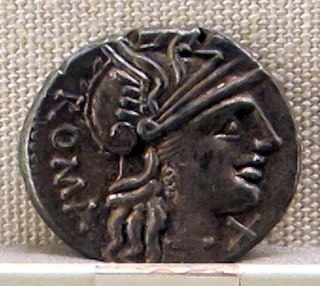Related Research Articles
The gens Gabinia was a plebeian family at ancient Rome. Members of this gens first appear in the second century BC. The nomen derives from the city of Gabii, east of Rome.
Publius Pomponius Secundus was a distinguished statesman and poet in the reigns of Tiberius, Caligula, and Claudius. He was suffect consul for the nundinium of January to June 44, succeeding the ordinary consul Gaius Sallustius Crispus Passienus and as the colleague of the other ordinary consul, Titus Statilius Taurus. Publius was on intimate terms with the elder Pliny, who wrote a biography of him, now lost.
The gens Scribonia was a plebeian family of ancient Rome. Members of this gens first appear in history at the time of the Second Punic War, but the first of the Scribonii to obtain the consulship was Gaius Scribonius Curio in 76 BC.

The gens Minucia was an ancient Roman family, which flourished from the earliest days of the Republic until imperial times. The gens was apparently of patrician origin, but was better known by its plebeian branches. The first of the Minucii to hold the consulship was Marcus Minucius Augurinus, elected consul in 497 BC.
The gens Afrania was a plebeian family at Rome, which is first mentioned in the second century BC. The first member of this gens to achieve prominence was Gaius Afranius Stellio, who became praetor in 185 BC.
The gens Calvisia was an ancient Roman family, which first rose to prominence during the final decades of the Republic, and became influential in imperial times. The first of the gens to obtain the consulship was Gaius Calvisius Sabinus in 39 BC.
The gens Coruncania was a plebeian family at ancient Rome. The first of the family to come to prominence was Tiberius Coruncanius, a novus homo who became consul in 280 BC, and dictator in 246.

The gens Munatia was a plebeian family at Rome. Members of this gens are first mentioned during the second century BC, but they did not obtain any of the higher offices of the Roman state until imperial times.
The gens Oppia was an ancient Roman family, known from the first century of the Republic down to imperial times. The gens may originally have been patrician, as they supplied priestesses to the College of Vestals at a very early date, but all of the Oppii known to history were plebeians. None of them obtained the consulship until imperial times.
The gens Petreia was a minor plebeian family at ancient Rome. Members of this gens are first mentioned toward the end of the second century BC, and several were distinguished as soldiers, but none of them ever attained the consulship.
The gens Pleminia was a minor plebeian family at ancient Rome. The only member of this gens mentioned in history is Quintus Pleminius, infamous for his outrageous conduct at Locri during the Second Punic War. Other Pleminii are known from inscriptions.
The gens Rammia was an obscure plebeian family at ancient Rome. Members of this gens are first mentioned in the period leading to the Third Macedonian War, but no Rammius attained a position of importance in the Roman state until Quintus Rammius Martialis, governor of Egypt early in the second century AD.
The gens Belliena or Billiena was a minor plebeian family at ancient Rome. Bellienus is the form that occurs in writers, while Billienus is more common in inscriptions. Members of this gens are first mentioned toward the end of the Republic. Lucius Bellienus obtained the praetorship in 107 BC, but was prevented from obtaining the consulship. The Bellieni occur in history down to the time of Caesar, after which the family faded into obscurity; but others are known from inscriptions.
The gens Rubria was a plebeian family at ancient Rome. Members of this gens are first mentioned in the time of the Gracchi, but they did not rise to prominence until imperial times. The first of the Rubrii to obtain the consulship was Rubrius Gallus, some time before AD 68.
The gens Saenia was a plebeian family at ancient Rome. Members of this gens are first mentioned in the final century of the Republic, and Lucius Saenius attained the consulship in 30 BC.
The gens Sallustia, occasionally written Salustia, was a plebeian family at ancient Rome. Members of this gens are first mentioned in the time of Cicero, and from that time they attained particular distinction as statesmen and writers. The most illustrious of the family was the historian Gaius Sallustius Crispus, who wrote valuable works on the Jugurthine War and the Conspiracy of Catiline, which still exist.
The gens Thorania, also written Torania, was a minor plebeian family at ancient Rome. Only a few members of this gens are mentioned in history, but others are known from inscriptions.
The gens Tituria was an obscure plebeian family at ancient Rome. Few members of this gens appear in history, of whom the most famous is Quintus Titurius Sabinus, one of Caesar's legates during the Gallic Wars. Other Titurii are known from inscriptions.
The gens Turullia, occasionally spelled Turulia, was an obscure plebeian family at ancient Rome. Only a few members of this gens appear in history, but others are known from inscriptions.
The gens Urbania was an obscure plebeian family at ancient Rome. No members of this gens appear in history, but several are known from inscriptions.
References
- ↑ Chase, pp. 125, 126.
- ↑ Dionysius of Halicarnassus, Roman Antiquities, ix. 40, 41.
- ↑ Broughton, vol. I, p. 30.
- ↑ Sallust, Historiae, ii. 70.
- ↑ Broughton, vol. II, p. 103.
- ↑ Valerius Maximus, xi. 8. § 6.
- ↑ Appian, Bellum Civile, iv. 6. § 44.
- ↑ Quintilian, iv. 1. § 11; vii. 2. § 7; 3. §§ 1, 26; 4. § 1.
- ↑ Tacitus, Dialogus de Oratoribus, 38.
- ↑ PIR, vol. III, p. 490 (V, No. 682).
- ↑ CIL X, 3389.
- ↑ AE 1979, 166.
- ↑ CIL V, 7769.
- ↑ AE 1995, 1773.
- ↑ Bakker and Galsterer-Kröll, Graffiti auf römischer Keramik im Rheinischen Landesmuseum Bonn, 547.